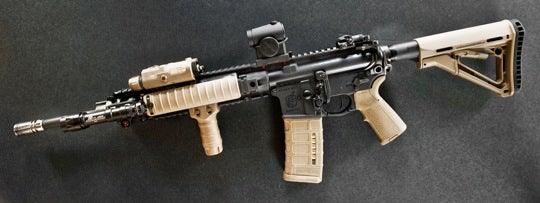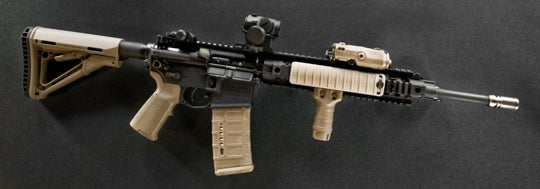[ I am pleased to present this post written by Isaac. ]
Knights Armament as a company has had a notable hand in the evolution
of Eugene Stoner’s classic AR-15 design. One of the most obvious
results of that heritage is visible in the SR-15 E3 IWS (Integral
Weapons System).
The biggest question when people see the SR-15 is “what’s different
about this gun to make it special?” And to answer that is to look
under the hood and understand that the SR-15 doesn’t seek to be the
most accurate, or the most durable gun (the SR-15 E3 IWS actually
groups 1.25moa or better, so it’s no slouch). What it does is be one
of the most complete package rifles that require almost no user
modification or tweaking. And by doing so is an incredibly reliable
and lightweight rifle with a plethora of features.

From the inside out Knights has given the SR-15 a longer than mid-
length gas system, which provides for an extremely smooth and reliable
operation. The rifle also features a larger bolt cross section, which
serves to improve overall durability. The hammer forged barrel groups
very well, and in combination with the very lightweight URXII rail
(including integrated front sight, and included match grade rear
sight), gives the gun an extremely svelte appearance and light overall
weight. All combined with their match grade trigger assembly and
offering completely ambidextrous controls to those who are southpaws
(or shooters working off their reaction sides).
So, SR-15 feature primer aside, how well does it actually shoot?
Amazingly well. Having run the gun in a few carbine courses and
competitions, and run it hard, the gun has easily become the rifle I
count on as my ‘go to’ gun. What it offers me is an extremely
lightweight rifle (even running lights and lasers) that gives me an
above average level of accuracy from a fighting carbine. Short of
changing out some furniture to fit my personal needs, the gun has not
required any tuning or fixes. An extremely smooth gas system in
combination with the Knights Armament triple tap brake (not included)
creates a rifle with almost zero muzzle flip. In the end what the
rifle brings to me is a gun that far exceeds my own capabilities as a
shooter.
The value of the SR-15 E3 IWS is obviously relative to the needs of
the shooter. Some may never need the features of the SR-15, and that’s
a valid point. However considering what you get as a package (LMT
SOPMOD stock, 16” hammer forged barrel, ambidextrous lower,
lightweight continuous railed forearm, etc) you’re getting a great
value. For those who want or need a gun that requires practically no
modifications to achieve maximum durability and performance, this is
obviously an excellent choice that far exceeds the levels of what make
up a top tier AR-15 rifle.
 Your Privacy Choices
Your Privacy Choices


